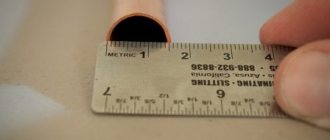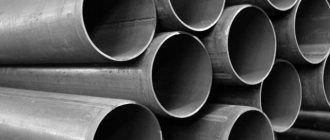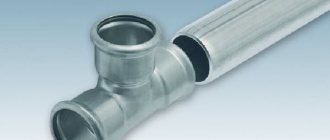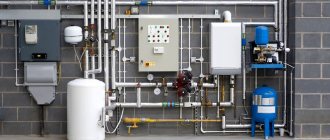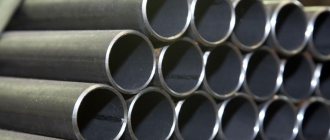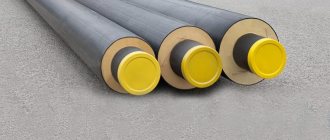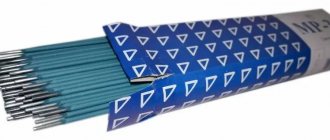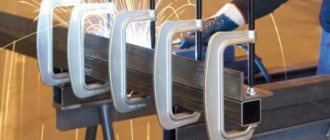The outer and inner diameter of metal pipes.
In the manufacturing process of metal pipes, their outer diameter is taken as a basis. Also, based on the general division of pipes into 3 types, the following applications are possible:
- Small pipes are used to install water supply in apartments.
- Medium-diameter pipes are suitable for installing urban water supply systems. In addition, crude oil is extracted using medium pipes.
- Large diameter pipes are almost always used in the construction of main oil and gas pipelines.
The internal diameter of metal pipes is not standardized according to GOST and is available in different sizes.
To organize the difference in the internal diameter of metal products, a special parameter is used - “conditional bore (Dу)” . This parameter is the minimum internal diameter of the pipe, rounded to the nearest whole number. The value of Dу is designated according to GOST 355-52. To calculate the internal diameter, subtract twice the wall thickness from the external diameter of the pipe.
What influences the indicators
The choice of characteristics for equipment in a private home depends on the load on the system. The diameter of the pipes is affected by the pressure in the water supply. The higher the indicator, the larger size should be used. A thin stream from the tap will be the result of inappropriate parameters with low pressure. When capacity is exceeded, breakthroughs and accidents occur.
The choice of pipe diameter depends on the type of water supply. In a private house, 2 types of connections are possible:
- Mainline. The liquid to the cottage comes from the central system. To ensure that all consumers have moisture, the equipment parameters should not exceed 32 mm.
- Autonomous. Moisture enters a private house from a well. The characteristics are selected from the operating characteristics of the building.
The diameter of the water pipe is affected by the number of intake points. Moisture consumption in a private house is greater than in a city apartment. If the characteristics of the equipment are not suitable, then when you open the tap or turn on the washing machine, the pressure in other parts of the cottage decreases.
Design for a country house Source 1-teplodom.ru
The diameter of the pipe depends on the length of the water supply. Large elements are installed in an extended system. If the parameters at the dacha do not exceed 10 m, then pipes up to 20 mm are sufficient. In a multi-storey cottage, the equipment footage reaches 30-50 m, so the thickness of the elements varies between 25-50 mm.
The diameter of the pipe is also affected by the complexity of the water supply system. Each bend reduces the pressure in the system. When the washing machine and shower operate simultaneously, the pressure decreases throughout the entire structure. Experts recommend taking conductive elements with a reserve, preventing possible problems.
The diameter of the water supply pipes in a private house depends on the number, type and cross-section of all connected components. Installation of pumping equipment, meters and fittings narrows the path of the liquid. The more objects in the system, the greater the hydraulic losses. To neutralize the problem, experts recommend trying to reduce the number of nodes.
What affects the diameter Source trubyda.ru
The diameter and wall thickness of the pipes depend on the purpose of use. For cold water supply, the parameters of plastic models vary from 1.9 to 5.8 mm. For hot readings there are from 3.4 to 10.5 mm.
The characteristics in the passport consist of an external (outer) circumference and an internal value.
Manufacturers of water pipes often indicate the diameter in inches, the parameters of which in the traditional metric system are 25.4 mm. Sometimes on the packaging the cross section is written with an inclined line. The first number is responsible for the external characteristics, the second is the wall thickness. The internal size is determined by calculation.
Diameters of plastic pipes.
In the modern world, various plastic pipes are most popular: polypropylene, polyethylene, metal-plastic. Most companies that manufacture plastic pipes use their own sizing chart. As a result, when arranging a water supply system, it is better to use components from one manufacturer.
Table of diameters of plastic pipes
Basic requirements for water pipes
The characteristics of the installed communications must meet the requirements for water supply systems:
- Resistance to corrosion and aggressive impurities;
- Resistance to the formation of sediments and scale on the internal surfaces of pipes, which reduce the effective cross-section;
- Mechanical strength, ability to withstand water pressure;
- Heat resistance;
- Long service life;
- Simplicity of pipe connections during installation;
- Dimensions and weight;
- Reasonable cost;
- Satisfactory appearance.
Diameter and weight of cast iron pipes.
Nowadays, water supply systems made of cast iron pipes are practically not applicable in apartments. The main reasons: great fragility and very heavy weight. At the same time, due to the durability of the material, cast iron water pipes are laid in external conditions.
From this table you can find out how much a cast iron pipe weighs:
Table of diameters of cast iron water supply pipes
Wiring diagram
The choice of pipe parameters depends on the type of water supply network. With a series (tee) connection, all water intake points are installed one after another. Due to the small number of key parts, the method allows saving costs on materials.
When turned on at the same time, due to weak pressure, little fluid will flow to the remote component. To neutralize the problem, you need to choose the correct pipe diameter. It is recommended to take elements whose parameters are one step smaller than the main system. The technique helps to increase the pressure in diversion structures.
Tee pipe routing Source posudachimodache.ru
The collector wiring diagram allows you to connect several water intake points in parallel to a source or main line. For each device, an individual line with a valve is assembled. The pressure remains stable during simultaneous operation.
When choosing the diameter of the pipes, they are based on the length of the parts and the characteristics of the pipeline. Installing a collector circuit consumes more materials. The throughput of a properly designed water supply system is not dependent on the number of bends and connected devices.
Collector wiring diagram Source myosu.ru
How to correctly convert inches to mm.
Inch is an English unit of measurement equal to 2.54 cm. When marking products, inches are indicated by numbers with quotation marks (1″, 2″, etc.)
For example, in order to calculate the outer diameter of a pipe = 1″, you need to add the wall thickness multiplied by 2 to 2.54 cm.
Table for converting pipe diameters from inches to mm
When carrying out work on installing a water supply system, it is necessary to observe the dimensions as accurately as possible. Otherwise, the water supply joints will not have a sufficient degree of tightness. And the service life of such a system will be significantly reduced as a result of leaks.
How to determine the diameter
To select the correct pipe parameters in the water supply system, it is necessary to calculate the throughput of the equipment. With constant pressure and a small cross-section, the pressure in the system will be high. Operating at the limit reduces the reliability of the elements, which will lead to an accident.
Inside the house
For water supply pipes are used, the diameter of which varies from 16 to 100 mm. Due to the low safety factor, models with an indicator of 63 mm and above are rarely used for a country house. The structures cannot withstand the pressure of the passing liquid, which causes cracks to appear on the surface.
To work with household appliances, pipes with a diameter of 16 to 32 mm are installed. For appliances, it is recommended to install elements with a cross-section of 25 mm, for showers, washbasins and bathtubs - 32 mm. When arranging internal sewerage, preference is given to models with parameters of 50 mm. For drains from a washing machine or dishwasher, 40 mm is sufficient.
The capacity of the pipes depends on the number of water intake points and the flow rate of liquid inside the cottage. Up to 5 liters per minute passes through the faucet in the sink. When passing 25-30 liters, a cross-section of 25 mm is sufficient. In a building with 10 mixers, the figure increases to 50 l/min, so a diameter of 32 mm is suitable.
Materials used for making pipes
Depending on the purpose and operating conditions, metal, polymer, metal-plastic and asbestos-cement pipes are used.
Metal pipes are made from:
- Cast iron;
- Structural steel;
- Galvanized steel;
- Of stainless steel;
- Copper
The most common materials for non-metallic pipes are:
- Polypropylene;
- Polyethylene;
- PVC;
- Metal-plastic;
- Asbestos cement
Features and Specifications
Steel water pipelines have the following characteristics. Some positive aspects have already been partially discussed above, but not everything is so rosy with this pipe rolling range.
It also has negative characteristics:
- Corrosive formations. Unfortunately, steel is susceptible to this effect. And the water supply system feels this with particular acuteness. In it, moisture is constantly combined with atmospheric oxygen. Such a combination is simply destructive for steel.
- Decrease in lumen over time. Such a highway tends to become overgrown over time. Her clearance can catastrophically decrease in just a couple of years.
- Labor-intensive installation and dismantling. Speaking about a steel pipeline, we must immediately make a reservation that assembling it is more difficult than tightening several nuts on fittings of a metal-plastic structure, or welding polypropylene pieces with a small welder. Connecting a steel water pipe will require the participation of a professional welder.
- Impressive weight. This characteristic feature of steel water supply pipe materials greatly complicates transportation and installation.
IMPORTANT! Steel networks can be protected from such a significant drawback as corrosion by priming and painting.
Types of steel pipes
The diameters of steel pipes are important, but not the only criterion. The manufacturing method plays a major role in the possibility of further exploitation. There are several types:
- Straight-seam . To make electric-welded pipes, you have to use sheet steel. The essence of production is simple: the material is bent to the required diameter, after which the structure is fixed in this form. Conventional welding is used to connect the edges. Thanks to this, the seam width is reduced to a minimum. To control the quality of manufactured products, the manufacturer checks the compliance of the characteristics with the regulated standards established in the relevant sections: GOST 10704-91, GOST 10705-80 GOST 10706-76.
- Pipe compliance with 10706-26 is an excellent indicator and can tell a lot about the product. As practice shows, this is one of the most profitable offers on the market, if you rely on the price/quality criterion. Such pipes are double reinforced inside and outside, so they can boast a long service life. The size ranges from 10 to 1420 millimeters.
- When using steel in coils, spiral-welded pipes are obtained. Their seam is much larger than their predecessors, which negatively affects the characteristics. For example, such a pipe will cope much worse with high internal pressure.
- Seamless representatives are justifiably considered the best. The process of their manufacture is much more complicated, but can be done even without the use of high temperatures. Due to the absence of a seam, the pressure is distributed evenly and there are no weak points.
The seam is the most vulnerable spot Source svarkaed.ru
To understand which type is best to purchase, you need to decide on the tasks. If the load exerted is small, a spiral suture option is also suitable. If the system has to cope with really difficult tasks, it is better to give preference to a seamless analogue. There is no point in saving, as they say: “The miser pays twice.” It’s better to do everything right away with high quality than to make numerous modifications later.
See also: Catalog of projects of houses with a garage
Duration of operation
The list of important technical characteristics includes the service life of the finished structure. This indicator largely depends on the conditions in which the pipeline is located.
Non-galvanized structures that are constantly in contact with cold water fail over several decades, as the walls under the threads gradually become thinner and the clearance decreases.
Galvanized products, even in contact with humidity, can last 50-80 years without repair.
The absence of humidity (gas pipeline) allows the facility to be operated for more than 80 years.
Properties of polypropylene
Although polypropylene is the least dense of all plastics, it is more resistant to abrasion, tolerates heat better, begins to soften only at 140°C, is chemically resistant, and almost does not crack as a result of corrosion. The material is plastic. Under loads not exceeding the maximum, it stretches and then returns to its previous shape without any changes in properties and characteristics. So it's a really good and safe option. Pipelines in food factories are made from polypropylene pipes.
An additional plus is that polypropylene pipes are easy to connect - they are welded. In general, not only water pipes and heating are made from polypropylene. This material can be used as a frame for greenhouses, country furniture and a bunch of other useful things.
As you can see, the diameters of polypropylene pipes are different. And that's not all. There is also up to 1600 mm
Polypropylene has two disadvantages: high thermal expansion and reaction to oxygen and ultraviolet radiation. We learned to deal with both. In order for polypropylene to tolerate UV rays and light, stabilizers are added. To reduce thermal expansion, reinforced pipes are made. But even with reinforcement, the increase remains large and compensators must be installed in pipelines.
Another disadvantage of polypropylene pipes is that they become brittle at low temperatures. Some types begin to crumble at -5°C, others at -15°C. So external pipelines made of polypropylene require UV protection and insulation. That's why they probably prefer to bury them.
How to deal with import designations
There are not only products from domestic manufacturers on the market. There are pipes marked according to the American system. Let's start with the fact that they distinguish between two types of pipes: pipes and tubes. Both words translate as pipe, but they are intended for different systems and the requirements for them are different.
Pipes type
Type of Pipes - electric welded and seamless. They are designed for transporting liquids and gases. So this is exactly the type that can be used in our heating and water supply systems. The main characteristic of pipes type pipes is the internal diameter. There are two strength standards in this group, which determines wall thickness and operating pressure.
- Schedule 40 or standard. The designation may include st (as in the figure below). These are products with standard wall thickness.
- Schedule 80 or extra heavy. The designation is EX. This is a material for use in high pressure pipelines.
Difference in internal diameters of Pipes of different strength categories: standard and heavy
As you understand, with the same external size, the clearance will be different. Let's take a two-inch pipe as an example. It is designated as NPS=2″ internal diameter in different designs differs:
- standard (standard) schedule 40 - 2.067 inches (which is approximately equal to 5.25 cm);
- extra heavy schedule 80 - 1.939 inches (approximately 4.925 cm).
These categories standardize wall thickness and maximum operating pressure. The outer diameter remains constant, but the actual inner diameter changes with the wall thickness. That is, NPS=2″ describes the inside diameter, which will be about two inches, but will vary depending on the wall thickness. Here the situation is similar to our standards: there is a certain list of values to which actual parameters are rounded when labeling. Once again: if we are talking about a two-inch Pipe type pipe (the marking says NPS), you need to understand that we are talking about the internal diameter, but it will not be exactly two inches. It will be either a little more or a little less. Same with other sizes in inches.
Type Tubes
The word Tubes refers to pipes that are marked by outer diameter. The internal one will depend on the wall thickness. Therefore, this standard also contains the concept gauge, which can be translated as gauge. It just indicates the wall thickness.
The same diameters of steel pipes do not mean the same weight
The marking is marked with ASTM. The numbers following the abbreviation describe the outer diameter. In this group, we may be interested in copper pipes.
Advantages and disadvantages
Traditionally used for water supply systems, steel pipes have begun to cause many complaints regarding the corrosion resistance and durability of structures.
These facts explain the undeniable advantages of polymer products for a number of properties:
- Durability (25-50 years).
- High resistance to chemical attack.
- Smooth inner surface.
- No deposits on the walls that affect the purity of the transported drinking water.
- Resistance to corrosive processes.
- Light weight and easy to install structures.
- Thermal insulation properties.
- Heat resistance.
- Low price.
- Minimum operating costs.
- Does not require painting or waterproofing.
- Good soundproofing qualities
Flaws:
- the strength of steel pipes is higher than that of plastic fittings;
- when laying external networks in an open way, direct exposure to ultraviolet radiation reduces the service life of products;
- unreinforced polymer profile has a high linear elongation coefficient;
- diffusion of oxygen into transported liquids is possible.
Purpose of water pipelines
The supplied water can be used for different purposes:
- For drinking, cooking, personal hygiene purposes - residential premises, catering establishments, medical and educational institutions and others;
- For hot water supply to residential and industrial premises and structures;
- For heat supply;
- For the technical needs of industrial enterprises;
- For irrigation systems and watering in agriculture
